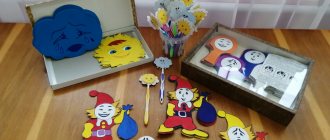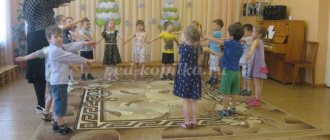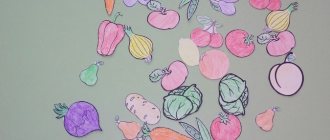Summary of the organization and management of a didactic game with children of the middle group
Author: Vyrodova Alexandra Nikolaevna
Didactic game (board-printed)
"Baskets with vegetables and fruits"
Didactic task:
- develop the ability to distinguish vegetables, fruits, berries
- find and name vegetables, fruits, berries
- choose baskets according to what is in them (large vegetables, in the largest basket, smaller fruits, in the medium one, berries in the smallest basket)
Game task:
-choose the right vegetables, fruits, berries, put them in baskets of the right size
Game rules:
Procedure:
- select all vegetables, fruits, berries,
- select the right basket for them
Materials and manuals:
3 baskets of different sizes, 7-9 vegetables, fruits, berries each according to the size of the baskets, 2 envelopes.
Progress of the game:
Surprise moment:
- Guys, yesterday I received a letter from Dunno (show the envelope containing the materials for the game), he asked to give this envelope to the children of the middle group of the Rodnichok kindergarten.
-You don’t know who this is?...
- Well, if it's you, then I delivered the letter correctly.
— In his letter, Dunno writes that he is kidnapped and that only you can free him if you correctly follow the rules of this game.
- Let's quickly see what kind of game Dunno sent us.
(I open the envelope and take out materials for the game)
- Guys, look what an interesting game! And here are the rules of the game (I give the children the opportunity to look at the game material)
(I say the rules at the beginning of the game)
— To save Dunno, you need to choose all the vegetables, fruits and berries correctly. Then you need to choose the right basket for them and put them in the baskets. But you must remember that vegetables are the largest, so they need the largest basket, and berries are the smallest, so they need the smallest basket.
- So, let's start collecting vegetables, fruits and berries, putting them in baskets in order to free Dunno as soon as possible.
(Children collect vegetables, fruits, berries in 3 baskets, the teacher prompts if necessary).
- That's it guys, all the baskets are collected, now we will put them back in the envelope and send them to Dunno so that he can be freed. (I put the baskets in an envelope, take the envelope away, and immediately return with another envelope).
- Guys, I received a second letter from Dunno, in which he thanks you for helping him free himself.
He praises you for your intelligence, for your ability to distinguish between vegetables, fruits, and berries, and promises that guests will soon come to you and play with you. comments powered by HyperComments
Outline of the didactic game “similar-dissimilar”
Outline of conducting a didactic game in the senior group
“LIKE – NOT LIKE”
Target:
Development of gaming skills in children of senior preschool age
Tasks:
1.
Teach children to compare objects, find similarities in color, shape, size, material;
the ability to find two identical objects and prove their similarity; 2.Develop observation, thinking, speech.
3. Cultivate a desire to play together, analyze each other’s actions
Equipment
:
various items that can be compared on some basis, some of them must be identical.
Move.
Place items in the room discreetly in advance.
Organize the children by saying that now we will play an interesting game “Alike - not alike.” Remind children that they are surrounded by many objects, different and identical, similar and completely different. Set a game task for the children: “Today we will find objects that are similar to each other. They can be similar in color, shape, size, material. Explain the rules of the game (you need to walk around the room, choose two similar objects and sit down. The one to whom the arrow points will tell you why he took these two objects and what is their similarity) .
The child who called them similar must prove the correctness of his choice. And so, in turn, all the children explain their choice. Ask children questions:
-Guys, what objects in the room are similar to each other?
-Children, what is the difference between a red ball and a blue ball? etc.
During the game, use instructions, reminders, explanations, and persuasion. Pay attention to children who have difficulty making descriptions and provide assistance to these children, taking into account their individual characteristics. At the end of the game, sum up the results with the children. Mark children who were active, pay attention to less active children. Invite children to express their opinion on the game. Invite the children to play this game next time.
infourok.ru
Didactic game on cognitive development for children of the preparatory group of preschool educational institutions
Summary of the game “What will be what?”
for children of the preparatory group for school Author: Likhovidova Sofya Mikhailovna. Position, place of work: student at Veshensky Pedagogical College named after. M.A. Sholokhov", specialty "Preschool education", Rostov region, Sholokhovsky district, Veshenskaya village. Description of the material: a summary of the game has been prepared for children in the preparatory school group. The didactic game is aimed at developing the cognitive interests of children (OO Cognitive Development). This summary may be of interest to both teachers of preschool educational organizations and students studying in the specialty “Preschool Education”. Group: preparatory. Goal: formation of cognitive actions. Didactic tasks: improve the ability to establish simple connections between subjects; continue to promote the development of the ability to think logically and answer questions in complete sentences; practice naming objects correctly. Developmental objectives: to promote the activation of children's speech; promote the development of memory, attention, thinking. Educational objectives: create conditions for nurturing independence, friendly relations in the group, respect for each other. Game task: answer what will be and what was. Game rules: catch the ball, answer the question, do not shout. Game actions: line up in a circle, catch the ball, answer a question. Equipment: ball, Dunno. Preliminary work: looking at illustrations, talking with children, watching videos, observing while walking.
Progress of the game
Educator: Hello, guys! My name is Sofya Mikhailovna. I am glad to see you all cheerful and healthy. Guys, do you know who I met near the gate of your kindergarten? I met Dunno (a crying Dunno enters the group)
.
Guys, let's ask him why he's crying? Children: Let's go. Educator: Dunno, answer us, why are you so sad? Dunno: I really like to play different games, but I can’t do a lot of things. That's why no one wants to play with me. Educator: Dunno, what game is causing you difficulties? Dunno: I can’t always answer the question in the game “What will be what?” Educator: Guys, can we help Dunno? Shall we play his favorite game with him? Children: Yes. Educator: Then for this we’ll take a ball. Dunno, stand in a circle with the guys. I will throw a ball to each of you and say a word, and you will have to answer what comes of it. Well, for example: an egg can produce a chicken, a bud can produce a leaf, and so on. The one with the ball in his hands answers; the others do not shout out. Guys, do you understand everything? Children: Yes. Educator: Dunno, if you find it difficult to answer, we will help you all together. Dunno: Okay! Educator: So, let's begin: Calf - cow Foal - horse Acorn - oak Caterpillar - butterfly Flour - dough / bread Chick - bird Lamb - sheep Leather - shoe Fabric - dress Board - closet Child - adult Educator: Well done, guys ! How much new things our Dunno will learn. Now let's do the opposite: I will say the word, and you will name what it used to be. For example: The table used to be a board, or the frog was a tadpole. Guys, do you understand everything? Children: Yes Teacher: Okay, let's continue: Dog - puppy House - brick Man - boy Mittens - wool Fish - egg Cat - kitten Plant - seed Goat - kid Paper - wood Glass - sand Pig - piglet Teacher: Guys, what a great job you are! Now our Dunno can play this game with his friends, because he has learned so many new things. Dunno: Yes, guys, thank you very much! Thanks to you, I have become smarter! And now, I ran to my friends. Goodbye! (Dunno leaves)
.
Children: Goodbye. Educator: Guys, what new game did you learn today? What is it called? Children: “What will happen?” Educator: Let's remember what paper used to be? What was glass? Well done guys, you worked really hard today. Dunno was very pleased!
We recommend watching:
Didactic game for kindergarten. Preparatory group Didactic games for the preparatory group of kindergarten Didactic games for children 6-8 years old Didactic game for speech development for children in the preparatory group
Similar articles:
Didactic games to familiarize yourself with flora and fauna for children of the senior preparatory group
Summary of the didactic game for children of senior preschool age “New Year’s Workshop”
Author: Elena Mikhailovna Smolnikova, teacher of the highest qualification category at the Children's Development Center - Kindergarten No. 272 (Perm).
Goal: to activate and enrich the experience of children solving cognitive-game tasks on the formation of sets of objects (geometric three-dimensional figures) on various grounds.
Didactic tasks : updating children's ideas about the essential and additional features of volumetric geometric shapes and their standards; children’s game-creative skills (modification of structural elements (rules), enrich the experience of game interaction, develop a conscious attitude to game rules and reflexive skills.
Game task: win a competition with peers (by quickly and correctly carrying out all game actions and rules).
Didactic rules: choose the right base for a prism, correlate the shape and size of a geometric body and a plane geometric figure (prism base). Choose the right base for the prism, match the shape and size, and decorate the Christmas tree with a toy of a similar shape.
Game rules: you can start completing a task only after the leader’s command, the task must be completed, following the rules, you can help another when you have completed your task, the team that decorates the Christmas tree faster and correctly wins.
Organizational and regulatory rules: carry a toy - a figure on the palm of your hand so that it does not tip over; do not interfere or push; if the toy is ready to stand up and show it on your palm; Decorate the Christmas tree by attaching toys one at a time.
Game activities: making a toy from a chosen shape, decorating a Christmas tree as a team.
Game content:
Option 1.
The game involves 10 players and 1 presenter. Players are divided into 2 teams. At the leader’s signal, players select a figure corresponding to their team and fill it with colorful contents. Whoever is faster gets one token. When all team members have filled (decorated) each of their (figures), at the leader’s signal, the players take turns running up and attaching the toy to the Christmas tree. The team that decorates the Christmas tree the fastest wins. The third token is received by the team that correctly selected the toys for the Christmas tree.
Option 2.
Changing the rules of the game. For quickly and correctly completing the task, each player receives a chip. At the end of the game, each team member hands over chips, they are added up, and the majority of the team’s chips leads to a win.
Guidelines:
Equipment: A set of hollow geometric figures, 2 Christmas trees of different shapes (pyramid cone), containers with colored fillers (colored rain, tinsel, threads, confetti), easel, 4 tables, 4 trays, a figure of Santa Claus, the Snow Maiden, a prize (didactic game) .
Progress of the game:
Option 1.
The children and the teacher sit on a carpet on which triangles and squares are glued.
Educator: What holiday are we looking forward to? It’s so beautiful in your garden, you’re waiting for Santa Claus. Santa Claus will come, and how affectionately will he call you? So he will call me Elena Mikhailovna. And what will Santa Claus affectionately call you? And you? The teacher gets to know the children.
— Who is the main guest at the New Year? I'll tell you a riddle, and you tell me.
Riddle about the Christmas tree.
Educator: The New Year has not yet come, and our music room has not yet been decorated. There is no Christmas tree. But you and I can hurry up the holiday. Look what I brought you. (Takes it out). These are Christmas trees, but not ordinary ones. They are from the land of geometry. How did you know these were Christmas trees? No needles, no branches.
Children: They look like Christmas trees in color and shape.
Educator: Is there anything different between them? Not similar? How are they different from each other?
Children: Different shapes.
Educator: That's right, one tree looks like a cone, you could say its edges are smooth, without corners. And this? What kind of figure does it look like? This figure is called a pyramid. It has edges and corners. Can these trees be called New Year's trees?
Children: No.
Educator: Why? (Not decorated). What should we do to make them happy?
Children: Decorate.
Educator: You have many different games in your group, some you play with: shopping, traveling, and with some you play on tables - these are games with rules. But, probably, you don’t have a New Year’s game with rules in your group. You can, of course, buy it in a store, but maybe they don’t sell it there. Can we come up with our own idea and try it? Our game, as you may have guessed, will be about New Year trees, which must first be decorated.
— What do they decorate Christmas trees with?
Children: Toys.
Educator: I invite you to the New Year's workshop. There are no ready-made toys, but I have this, but I don’t know if it’s possible to decorate a Christmas tree with this. I want to consult with you. (Takes out a tray with geometric shapes). What is this? Figures, what kind of figure is this? (Volume circle. Ball). (He examines it and lets the children examine it.) Name all the available figures. How do you know which pyramid it is?
Children: Count the angles at the base of the prism.
Educator: The base is what the prism stands on. Can these figures be turned into colorful multi-colored decorations for the Christmas tree? (Yes). How? What can we do?
Children: Decorate.
Educator: I have material that will help you make funny painted New Year's toys for the Christmas tree from these transparent shapes. It can be placed in molds and closed with a lid. Tell me, will any lid work? I have many caps of different shapes, let's check whether I need to carefully choose a cap for the prism, or can I take any? (Check 2-3).
“We will be craftsmen ourselves, we will make Christmas tree decorations, but we decided to come up with a game.” What kind of game can you come up with about how toys are made? To make the game work, you need to come up with a rule. If we have two workshops, then how can we find out who is the most skilled and the fastest? We can divide into teams. How to split up? According to the figures from which we will make toys. There are geometric shapes where you sit. Whoever is sitting in circles, come over. Christmas tree, what shape will you decorate? And those with squares? Those children who have circles get into the “Santa Claus” team, and those who have squares get into the “Snow Maiden” team.
(Approaches the “Santa Claus” team)
Educator: What figures will you choose?
Children: No corners.
Educator: Which Christmas tree will you attach it to?
Children: On a cone.
Also with the “Snow Maiden” team.
Educator: We have tables, there are Christmas trees, there is filler for forms, (takes out, puts the figures on the tables), there are figures. How will we divide the figures? By what criteria will we choose figures? With corners, without corners. For your Christmas tree, what shape will you choose? How will you choose a lid for the figure without corners? Prism base?
— What rules must be followed to win and receive a prize. I have prepared cards for you that will indicate the rules that we will discuss now, I have one rule, what do you think it means. Choose toys only one at a time. Why is this rule needed? (Otherwise we won’t have time). What other rules must be followed in this game? (Children offer rules).
— What other rules do you suggest for winning? For example, what rule must be followed so that the toy does not fall apart and its lid does not turn over? (Children offer rules, the teacher helps to formalize them in speech and hangs a sign on the flannelgraph).
- When you fill the toy and close it with a lid, you need to stand up, put the toy on your palm so that I, as the presenter, can understand that you have done it, and only then take the toy to the Christmas tree. When you carry the toy to the Christmas tree, you need to carry it on your palm so as not to spill the contents on the floor. It turned out to be a good rule. What rule will help us not to crowd around Christmas trees? (Don't interfere with each other). And one more important rule: we will work together as a team. What rule will help us not to interfere with each other? (Work together and in order).
— Let me remind you that you need to choose your figure, fill it with decorations, and choose a lid. Whichever team does it faster gets one point.
- Go to your desks. Is everyone ready? At my command, we begin to decorate. One two Three.
(Children complete the task, fill hollow geometric shapes with tinsel, select lids. The teacher observes and, if necessary, joins in the activity).
Educator: The team won... Receives 1 point. Now you need to decorate the Christmas tree. Form a column. One at a time, you need to run to the Christmas tree, stick it to the Velcro landmark, and return to your team.
Educator: Are the teams ready? One, two, three, run. Children take turns running up to the Christmas tree and gluing toy figures.
Educator: Which team finished faster? Receives 1 point. This team dressed up quickly. Who won? Remember, we agreed - to decorate the Christmas tree not only quickly, but also correctly. Is that right? Let's check. Teams check each other's results. For correctness, each team receives 1 point.
Summarize.
Educator: Did you like it? What did you like most about the game: inventing the game or playing it? Did the game turn out the way we intended? Why? Why didn’t the figurines break or the decorations fall apart? Why did everyone manage to place their toy on the Christmas tree? (The rules were followed, everyone tried very hard, they did everything together, they cheered for each other, they came up with rules for the game together, they offered such interesting ideas to each other). So, who is behind the fact that our game turned out very well, without one mistake? Who thinks that the game didn't work out at all? Anyone who thinks that we played the game well, but haven’t learned everything yet, needs to play a few more times. Is there a different way to play this game? Today you and I played a game that we invented ourselves. Well done! Let's see what Santa Claus brought. (There's a new didactic game in the bag)







